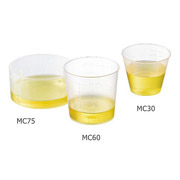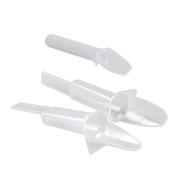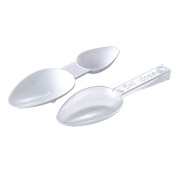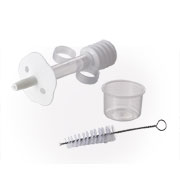Mothers Were Responsible For Overdosing For Baby? Or A Spoon ?
When people take too much medicine, the effect can be dangerous, especially to children.
Using a spoon when measuring medicine for young children can lead to giving too little or too much. For example, a large kitchen spoon can hold twice as much liquid as a small kitchen spoon.
Overdosing was the most common problem, with 68 percent of the 2,100 parents in the study making that mistake. Participants, mostly mothers, were responsible for caring for children 8 or younger.
Doctors are urging parents to ditch the spoon in favor of an oral syringe to measure medicine for young children, arguing that using spoons often leads to giving too little — or worse yet — too much of a good thing. In fact, too much of a good thing can make people sick.

The best tool for accuracy is an oral syringe or dropper, a baby syringe is the best. Even dosing cups or dosing spoons that come with many over-the-counter medications can pose a problem because the instructions often call for a teaspoon but the dosing cup is marked in milliliters, causing confusion.
Authors Koert van Ittersum, PhD and Brian Wansink, PhD, suggest that by indicating dosage measurements in milliliters people will opt for proper measuring devices as milliliters are difficult to estimate or eye-ball.
The concern about dosing mistakes was recently highlighted in a New York University-led study that found that a whopping 84 percent of caregivers made one or more dosing errors when giving medicine to younger children.
Overdosing was the most common problem, with 68 percent of the 2,100 parents in the study making that mistake. Participants, mostly mothers, were responsible for caring for children 8 or younger.
“Overall, we found high dosing error rates,” the study authors wrote in the journal Pediatrics. Parents who used dosing cups greatly increased the odds of making a mistake. This was particularly true when pouring out smaller amounts of medicine. (Unlike adult remedies, children’s medicine most often comes in liquid form.)
“Our findings suggest that health care providers should encourage oral syringe use for the measurement of liquid medications, particularly when small doses are recommended,” the authors concluded. “This change would probably benefit all families.”
Possible side effects of improper doses of medicine include nausea, irritability and increased blood pressure.
Both the American Academy of Pediatrics and the U.S. Food and Drug Administration recommend parents use syringes, droppers or dosing cups over spoons when giving medicine to children. That’s because standard silverware varies widely in size.
Or in other words, not all teaspoons and tablespoons were created equally.
Measuring Liquid Medicine
It’s important to measure liquid medicine accurately in order to get the right dose. Liquid medicine sometimes comes with a measuring device like a cup, spoon, or dropper. Be sure to use the right device in order to get the right dose. Check the markings carefully on the measuring device. Most liquid medicine is measured by teaspoon (tsp) or milliliter (mL) or cc.
1 mL = 1 cc
2.5 mL = 2.5 cc = 1/2 teaspoon (tsp)
5 mL = 5 cc = 1 tsp
15 mL = 15 cc = 3 tsp = 1 tablespoon (tbl or Tbsp)
30 mL = 30 cc = 2
Tbsp = 1 fluid ounce (oz)
If your liquid medicine doesn’t come with a measuring device, ask for one at the pharmacy. Some of the most common measuring devices include:
|
5ml Single End or Double End Dosing Spoons (Measuring Spoons) |
Be sure to measure liquid medicine at eye level, and never guess at the dose. Use the dose shown on the prescription label. This is especially important when giving liquid medicine to children.
Ask your doctor or pharmacist if you have any questions about measuring liquid medicine.
Very Easy To Take Liquid Medicines With Baby Oral Syringes For Children
It can be quite difficult to get children to swallow medicines from a spoon, especially young children. Children and babies are also often prescribed small doses of medicines, which are impractical to measure using a normal medicines spoon. The easiest way to administer medicines to a child is using an oral medicines syringe. This is a special measuring device used to accurately measure small doses of liquid medicine. You should be given either a normal medicines spoon or an oral syringe with your child's medicine when you collect it from the pharmacy. If you would like an oral syringe and have not been given one you should ask your pharmacist.
When using an oral syringe to administer a liquid medicine to a child:
- Remember to shake the bottle first to ensure the drug particles are evenly dispersed in the bottle
- Firstly pull the syringe plunger back to the required measure point, drawing air into the syringe
- Place the bung (which comes with oral syringes) into the top of the bottle and ensure that it is a tight fit
- Now push the syringe into the top of the bung, again ensuring a tight fit
- Push the air from the syringe into the bottle
- Turn the bottle upside down so that the liquid is at the bung end and pull out the required amount of medicine with the syringe. NB: If you do not push the air into the bottle first then you will find it hard to pull the liquid out
- Take the syringe out of the medicines bottle, then gently place the tip of the syringe in the child's mouth, just inside their cheek
- Gently push the plunger of the syringe down to dispense the medicine into the child's mouth. Allow them to swallow the medicine. Avoid pushing the plunger down forcefully or placing the medicine at the back of the child's throat. This may cause them to choke.
- Take the syringe out of the child's mouth




